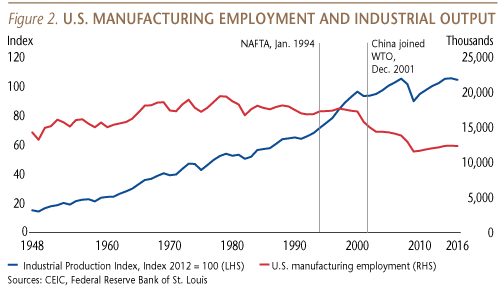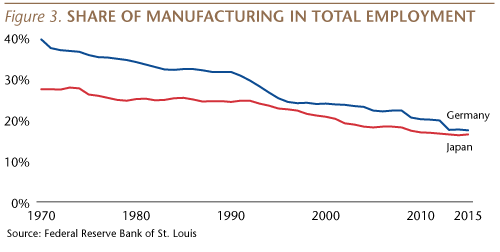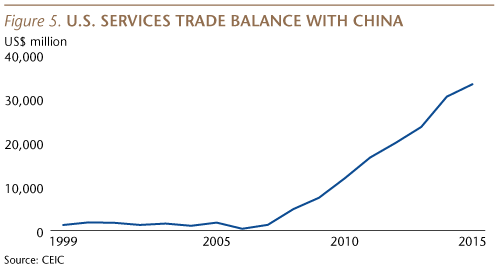Trump, Trade & China
Do most economists agree that trade is good for the overall welfare of societies and countries? We highlight the state of health of American manufacturing and its industrial output levels, and examine issues of employment and productivity.
Is trade bad for American companies, workers and consumers—especially trade with China? President Donald Trump appears to think so.
During a 2010 television interview, Trump said, “I would love to have a trade war with China.” Six years later on the campaign trail, he railed against the U.S. trade deficit as “not some natural disaster,” but a “politician-made disaster,” and called the North American Free Trade Agreement (NAFTA), “the worst trade deal in history.”
As president, Trump has declared, “We must protect our borders from the ravages of other countries making our products, stealing our companies and destroying our jobs.”
Nearly all economists agree that trade is good for the overall welfare of societies and countries. In this three-part Sinology series, we highlight that American manufacturing remains quite healthy, with industrial output at close to record levels. What has declined is manufacturing employment, leading to the popular (but incorrect) perception that American manufacturing is in trouble. In fact, the decline in such jobs is largely the result of good news: rising productivity.
Change—primarily from advances in automation, and from shifts in consumer spending preferences—has always led to labor market volatility. Some occupations expand and thrive, others fade away, and brand new occupations appear. But, technology, not trade, is the main driver of this trend.
We need to acknowledge, however, that over the last 15 years, a rapid rise in U.S. imports from China added to that labor market volatility, especially in labor-intensive sectors such as garments and furniture.
But China’s 2001 entry into the World Trade Organization (WTO) has not “enabled the greatest jobs theft in history,” as Trump has claimed.
It is also important to recognize that trade with China (and the rest of the world) is not a zero-sum exercise. U.S. workers and firms benefit significantly from exports to China. Since China joined the WTO, U.S. exports to China rose by 500%, while U.S. exports to the rest of the world were up by only 90%. One study found that U.S. exports to China directly and indirectly supported 1.8 million new jobs in 2015.
While U.S. firms continue to battle against non-tariff barriers and non-transparent government regulatory policy in China, many American companies have done well in that market. GM, for example, sold almost 4 million vehicles in China last year, and over the last five years, Boeing delivered more aircraft in China than in the U.S.
How can we help workers who have lost their jobs as a result of technological advances or imports? Protectionist policies are not the answer, as they would not bring back those jobs, and would lead to retaliation, which would reduce U.S. exports and have a negative impact on the many American jobs they support. Protectionism would also hurt American consumers, by raising prices and reducing choices.
Focusing on the U.S. trade deficit is also not a solution, as that deficit is determined by balances between savings and investments, rather than by trade policy. The trade deficit also has little impact on employment.
Instead, the U.S. government needs to do a better job supporting the small minority of the workforce that has been hurt by import competition, and a better job helping Americans learn the skills required by sectors where the U.S. retains a comparative advantage.
Trade is Good for Most of Us (Even Trade with China)
Since Adam Smith published “An Inquiry Into the Nature and Causes of the Wealth of Nations” in 1776 and David Ricardo wrote “An Essay on the Influence of a Low Price of Corn on the Profits of Stock” in 1815, almost all economists have agreed that trade is good for the overall welfare of societies and countries.
Ricardo coined the term “comparative advantage” to explain that even if one nation was great at making everything, it could still benefit by trading for some things. Thus, Ricardo wrote, “wine shall be made in France and Portugal . . . corn shall be grown in American and Poland, and . . . hardware and other goods shall be manufactured in England.”
U.S. President Ronald Reagan seemed to embrace Ricardo’s ideas, stating in 1986 that:
“There is one issue on which almost all responsible economists, whatever their political persuasion, are unanimous. They agree that free and fair trade brings growth and opportunity and creates jobs. And they all warn that high trade barriers, what is often called protectionism, undermines economic growth and destroys jobs. I don't call it protectionism; I call it destructionism. . . Instead of closing markets at home, we've opened markets to U.S. products abroad, thus helping to create more American jobs. Instead of erecting destructionist import barriers, we're tearing down foreign barriers to make trade freer and fairer for all.”
According to the Cato Institute: “It was the Reagan administration that launched the Uruguay Round of multilateral trade negotiations in 1986 that lowered global tariffs and created the World Trade Organization. It was his administration that won approval of the U.S.-Canada Free Trade Agreement in 1988. That agreement soon expanded to include Mexico in what became the North American Free Trade Agreement.”
Tim Harford, author of The Undercover Economist, engagingly explained the benefits of trade in a recent column for the Financial Times:
“The first and most fundamental insight is that all human civilization is built on some sort of trade. I’m not much of a farmer but, fortunately, I am able to trade the books I write for food and for the electricity that lets me cook. Even my books rely on others to make the paper, design the word-processing software, bind the pages, design the covers, handle the logistics . . . Some of this I could do myself, albeit slowly and incompetently. Other things I couldn’t begin to attempt.
. . . My home town of Oxford makes MINIs, which we can export in exchange for camembert. But what if a post-Brexit government decides to hammer the camembert trade? It’s not impossible: cabinet minister Liz Truss did once describe the U.K.’s reliance on foreign cheese as a ‘disgrace.’ French cheese makers would lose out but so, too, would the MINI factory in Oxford. The French use their camembert to buy our cars; if we’re buying less camembert, it means they’re buying fewer cars.”
“Deep down,” Harford notes, “trade is just another kind of productive technology—a technology that turns MINIs into camembert. Like any productive technology, it makes us richer.”
It is also worth noting that imports are good for American consumers. “Middle-class Americans gain more than a quarter of their purchasing power from trade,” according to the White House’s Council of Economic Advisors (CEA). “Trade allows U.S. consumers to buy a wider variety of goods at lower prices, raising real wages and helping families purchase more with their current incomes.”
Imports also enable Americans to eat well year-round, as about half of U.S. agricultural imports are fruits, vegetables, nuts and similar products.
American Manufacturing is Already Great!
Some politicians are now questioning the value of trade because they believe that American manufacturing is in decline. That belief is not supported by the facts. American manufacturing remains very healthy, with output close to record levels. From 1980 until the end of 2016—a period that includes the start of NAFTA and China’s entry into the WTO—U.S. industrial output is up 99%.

Manufacturing compensation has also risen at a healthy pace. Average compensation per full-time employee rose 64% in manufacturing and 61% in private industry between 2000 and 2012, according to the U.S. Government’s Bureau of Economic Analysis. What has declined is manufacturing employment, leading to the popular perception that American manufacturing is in trouble. In fact, the decline in manufacturing jobs is largely the result of good news: rising productivity in U.S. industry.
Manufacturing Employment Has Been Declining for a Long Time
While American manufacturing is very healthy in terms of output and productivity, employment in the sector has been declining for a long time. In fact, this decline in manufacturing employment began long before NAFTA (1994) and China’s WTO entry (2001).
The manufacturing share of total U.S. employment peaked in 1952, at 26% and has been declining ever since, reaching 8% in 2016, as a steadily rising share of jobs have come in services.
In absolute terms, the number of American manufacturing jobs peaked in 1978 at 19.4 million. That count continued to slide until 2009, when it reached 11.5 million, but the manufacturing employment headcount has been on a modest rebound in recent years, hitting 12.3 million in 2016. The number of job openings in U.S. manufacturing rose by 228% from June 2009 to the end of last year, to 325,000 jobs.

This trend of rising manufacturing output and falling manufacturing employment is not a strictly American phenomenon. In Germany, the manufacturing share of total employment fell to 17% in 2015 from 40% in 1970. In Japan, the manufacturing share of total employment fell to 16% in 2015 from 27% in 1970.

Even in China, industrial employment peaked in 2014 and by 2016 had declined by 8%, or by almost 8 million jobs. (And that data covers only larger firms, while there was likely similar level of job loss at smaller industrial companies.)
Productivity Has Kept Manufacturing Output Up and Manufacturing Employment Down
The main reason why America’s healthy manufacturing sector is employing fewer people is productivity. Simply put, U.S. factories are now able to produce more goods with fewer people.
A 2015 study by economists at Ball State University notes: “Almost 88% of job losses in manufacturing in recent years can be attributable to productivity growth, and the long-term changes to manufacturing employment are mostly linked to the productivity of American factories.”
In Illinois, for example, between 2006 and 2014, the number of manufacturing jobs declined by 15%, but total output rose by more than 2%. Analysis by the Illinois Economic Policy Institute cites that “productivity per worker thus increased substantially, mainly due to new technologies and automation…(revealing) that manufacturers as a whole are a beneficiary of free trade and automation.”
Steel is another (surprising) example of how productivity has enabled industrial firms to employ fewer workers. Productivity growth in the steel sector was one of the fastest in American manufacturing, according to a detailed analysis by economists at Duke and Princeton universities. “By 2000, the steel industry employed a fifth of the number of workers that it had in 1960, while production of steel went from 130 million tons in 1960 to 110 million tons in 2000. This implies that output per worker increased from 260 to 1,100 tons.”
The American Iron and Steel Institute, which represents the industry, says that “labor productivity has seen a five-fold increase since the early 1980s, going from an average of 10.1 man-hours per finished ton to an average of 1.9 man-hours per finished ton of steel in 2015.”
And, given the political sensitivity of this issue, it is worth noting that in 2015, imports of steel from China accounted for only 1.9% of U.S. apparent steel consumption, and that share averaged 1.7% annually between 2011 and 2015.
Technological Changes Have Created Job Polarization
M.I.T. economists Daron Acemoglu and David Autor have studied the transformation of American industrial employment, and in a 2002 report Acemoglu found that “a major driving force for this transformation is changes in technologies . . . [while] most evidence suggests that the direct effect of increased international trade on the U.S. labor market has been relatively minor.”
In a joint 2011 paper, the two economists reported that these technology-driven changes had resulted in a “marked pattern of job polarization in the United States and across the European Union—by which we mean the simultaneous growth of the share of employment in high skill, high wage occupations and low skill, low wage occupations.”
For middle-skill occupations—which the economists define as comprising sales; office and administrative support; production, craft and repair; and operator, fabricator and laborer—growth in the number of jobs has lagged the overall economy average.
The “polarization of employment” is driven by three factors, according to Acemoglu and Autor: “(1) rising employment in non-routine cognitive task-intensive professional, managerial, and technical occupations; (2) rising employment in non-routine manual task-intensive service occupations; and (3) declining employment in middle skill, routine task-intensive employment in clerical, administrative support and production occupations.”
Economists at the St. Louis Federal Reserve Bank have analyzed U.S. employment data and reached similar conclusions. The following chart shows very strong growth in non-routine cognitive (professional and technical) jobs (up 66% from January 1990 through March 2016) and growth in non-routine manual (services) jobs (up 46%). During that time, however, the number of jobs in routine cognitive sectors rose only 1.5% and routine manual sector jobs rose only 3.8%.

Nationally, from 1980 to 2007, total U.S. employment rose by 17.5%, and about half of that growth came in occupations that were brand new, driven by technological changes.
This job polarization is a key reason why a college graduate earns nearly twice as much over a lifetime (in present value) as a high school graduate, according to a 2016 study by the Federal Reserve Bank of Richmond.
The Rise of Services
We’ve noted earlier that one reason for declining manufacturing employment is the rising importance of the services sector in the U.S. economy, and this is worth describing in a bit more detail.
American consumer spending patterns have changed significantly. In 1959, just over half (54%) of personal consumption expenditure (PCE) was on goods, with only 46% spent on services. By 2016, however, the goods share of PCE had fallen to only 32% while the services share rose to 68%. This reflects that as people get richer, they increase spending on services more than they increase spending on goods.
This helps explain why service industries account for about four-fifths of the U.S. economy and employ over 80% of American workers, with both of these shares rising steadily since the middle of the last century.
(Of course, this is not just an American trend. In the U.K., for example, services accounted for 79% of total employment in 2014.)
And service jobs are not all about flipping burgers. Professional and business services, for example, employ about 17% of all private-sector American workers, and about 60% more employees than the manufacturing sector. Average earnings at the end of 2016 for professional and business services workers was 20% higher than for all private employees and 18% above average manufacturing earnings, according to data from the Bureau of Labor Statistics.
Services have also been a strong sector for U.S. exports, worth about US$710 billion in 2014, or 30% of total U.S. exports. These exports include insurance, financial services, travel, transport and intellectual property.
While U.S. exports of services to China are still small relative to the size of the U.S. trade deficit with that country, the services trade surplus with China was US$33.3 billion in 2015, up 17 times from a decade ago.

Concluding Comments
In this issue of Sinology, we’ve made the case that trade is good for most American workers, consumers and companies. We explained that American manufacturing is already great (with output at close to record levels), and that the loss of manufacturing jobs has been primarily due to improvements in productivity, not competition from imports. In the next issue, we will look at the impact that Chinese imports have on U.S. employment, the American jobs supported by exports to China, and the reasons why protectionism isn’t the solution to helping those whose jobs have been lost due to trade competition. Our final issue of this series will explore the relationship between trade deficits and employment.
Andy Rothman
Investment Strategist
Matthews Asia
As of February 28, 2017, accounts managed by Matthews Asia did not hold positions in General Motors, Boeing and The British Motor Corporation Limited (manufacturer of the MINI).
